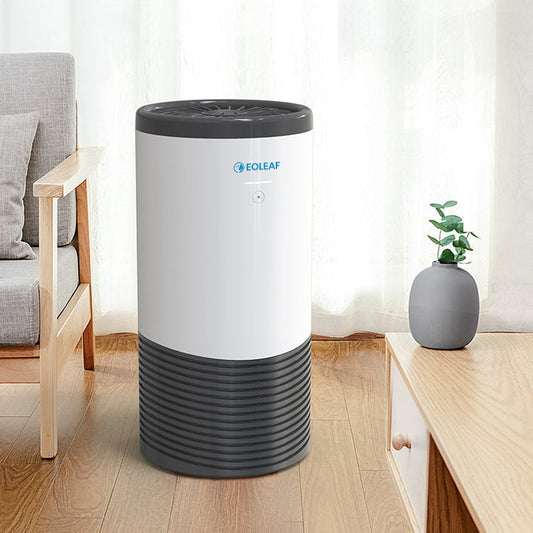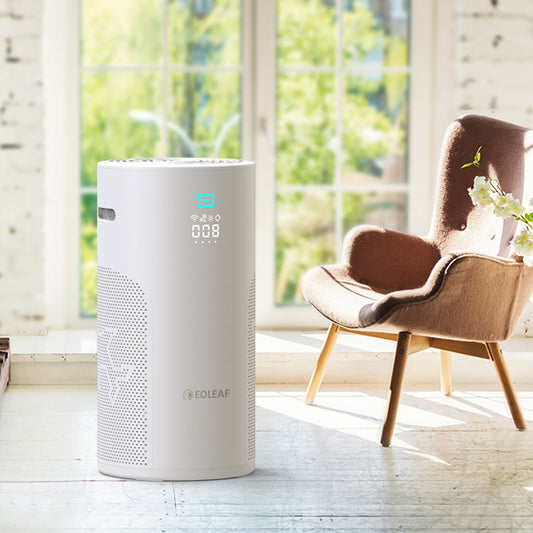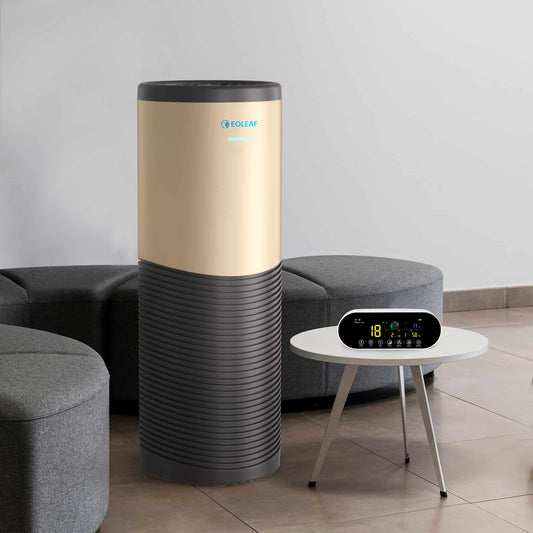Study of the effectiveness of Eoleaf purifiers
Octopus Lab carried out this study at our request in order to quantify the impact of our Eoleaf air purifiers on the transmission of the virus and on the rate of fine particles in concrete and realistic scenarios. Octopus Lab is a French company specialising in forecasting indoor air quality in buildings.
Below you will find a summary of the study.
I - Scenarios
Three scenarios were observed, and the selection criterion for these scenarios was simple: find meaningful and common scenarios, the results of which can be extrapolated to as many situations as possible. The first scenario applies to indoor catering in general (school cafeterias, company dining hall, restaurants, cafes, bars, etc.). As for the second scenario, it illustrates the situation for any common workspace (offices, coworking, public buildings, etc.).
Scenario 1: Cafeteria of 200m2 - Without wearing a mask (during meals) - From 11 a.m. to 3 p.m.
Scenario 2: Open space of 80m2 - Without wearing a mask - From 9 a.m. to 6 p.m.
Scenario 3: Open space of 80m2 - With mask wearing - From 9 a.m. to 6 p.m.
In all three scenarios, we took the most conservative case, that is, with the windows and doors closed and a viral load that builds up over time.
II - Methodology
The study was carried out using the INDALO software and its INCA-Indoor © calculation engine, developed by Octopus Lab SAS. For their analysis, they used the NF standard certified performances of Eoleaf air purifiers: the Clean Air Delivery Rate (CADR) as well as the technical characteristics of the various technologies used in Eoleaf devices, which have shown their effectiveness in such situations (filter HEPA H13, UVC lamp, and ionisation).
Several mechanisms are taken into account for the performance analysis:
- Virus emission (via the famous droplets and aerosols)
- The fate of the virus in the indoor environment (residence and survival time of the virus in the particulate phase and on surfaces),
- Occupant exposure to the virus (virus transmission routes and exposure time, protective effect of the mask when worn)
- The effect of the virus on the body (infectious power of the pathogen depending on the routes of transmission)

Description of the different emission, elimination and transmission mechanisms of SARS-Cov-2 which were taken into account in the modeling
III - Results
III.1 Fine particles
We will refer here mainly to ultra-fine particles “PM1” (with a diameter of less than 1 micron, or 100 times smaller than a hair), but it should be noted that the results are the same for fine particles PM2.5 and PM10. The graphs relating to these particles can be found in the appendix of the study.
Scenario 1: Cafeteria of 200m2 from 11am to 3pm
In this scenario, we study two sub-scenarios: the use of a single Eoleaf AEROPRO 100 (blue curve) versus the use of two Eoleaf AEROPRO 100s (yellow curve). The purifiers are turned on at noon and turned off at 3 p.m. The reference curve is the red curve.
There is a sharp and rapid drop in the level of PM1 particles in the air as soon as the purifiers are switched on, and the rate stabilizes near 0 after about an hour.
There is a gradual rise in the pollution rate from 3 p.m., once the purifiers are turned off.

Scenario 2: Open Space of 80m2 from 9 a.m. to 6 p.m.
In this scenario, five sub-scenarios are studied: the use of a single Eoleaf AEROPRO 100 at full speed (red curve), at moderate speed (green curve), or at low speed (yellow curve); the use of a single Eoleaf AEROPRO 150 at full speed (grey curve), at moderate speed (green curve), or at low speed (yellow curve); and the use of two Eoleaf AEROPRO 150s (turquoise blue curve). The purifiers are turned on at noon and turned off at 3 p.m. The reference curve is the dark blue curve.
There is a sharp and rapid drop in the rate of PM1 particles in the air as soon as the purifiers are switched on, and the rate stabilizes near 0 in a few minutes when using two devices or a single device at high speed. There is a gradual rise in the pollution rate from 6 p.m., once the purifiers are turned off.

III.2 COVID-19
Scenario 1: cafeteria of 200m2 without wearing a mask (to eat) from 11 a.m. to 3 p.m.
In this scenario, we study four sub-scenarios: the absence of any purifier (red curve), the use of a single Eoleaf AEROPRO 100 at full speed (yellow curve), the use of two Eoleaf AEROPRO 100s at full speed (light green curve), and the use of two Eoleaf AEROPRO 150s at full speed (dark green curve).
The risk of infection is reduced by up to 40% with the use of Eoleaf air purifiers.

Scenario 2: Open Space of 80m2 without wearing a mask from 9 a.m. to 6 p.m.
In this scenario, we study six sub-scenarios: the absence of any purifier (red curve); the use of a single Eoleaf AEROPRO 100 at low speed (pink curve), at moderate speed (orange curve), at full speed (yellow curve); the use of a single Eoleaf AEROPRO 150 at full speed (light green curve); and the use of two Eoleaf AEROPRO 150s at full speed (dark green curve).
The risk of infection is reduced by up to 40% with the use of Eoleaf air purifiers.

Scenario 3: Open Space of 80m2 with mask wearing from 9 a.m. to 6 p.m.
In this scenario, we study four sub-scenarios: the absence of any purifier or mask (red curve); the use of a single Eoleaf AEROPRO 100 at full speed and without a mask (orange curve); the absence of a purifier with mask wearing (yellow curve), and the use of a single Eoleaf AEROPRO 100 at full speed and with mask wearing (orange curve)
The risk of infection is reduced by up to 90% with the combined use of the mask and air purifiers from Eoleaf. We also see the importance of wearing a mask in interior office-like spaces.

IV- Study conclusions
The study points to several conclusions that are as relevant as they are interesting:
1) The proven effectiveness of our purifiers against COVID-19.
“The Eoleaf AEROPRO 100 and AEROPRO 150 purifiers are effective in decreasing the risk of infection with COVID-19 when they are used according to their surface area recommendations. Thus, two AEROPRO 100 purifiers with a maximum speed (i.e. 1000 m3 / h in total) installed in a 200 m2 dining hall reduce the risk of COVID-19 infection by 40%. The finding is the same in the 80m open space."
2) Particulate filtration is the most efficient of the technologies studied.
3) The operation of the purifiers after the occupants have left "allows an extremely rapid decrease in SARS-CoV-2 in the air phase, and ensures that the concentrations are almost zero if the room is reused".
4) Cleaning surfaces remains important, just like the other barrier gestures (social distancing and wearing a mask).








